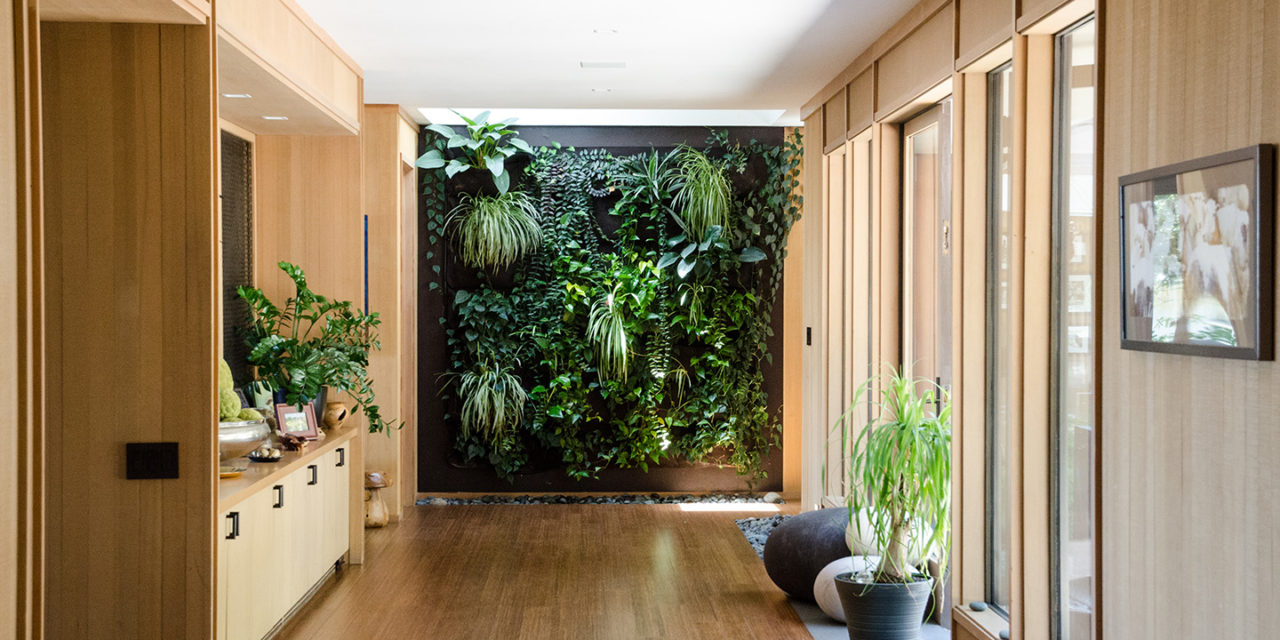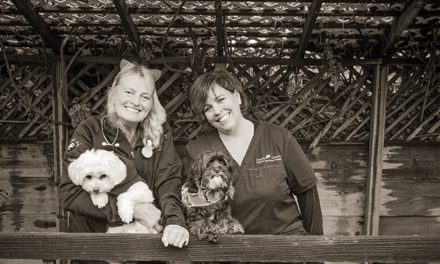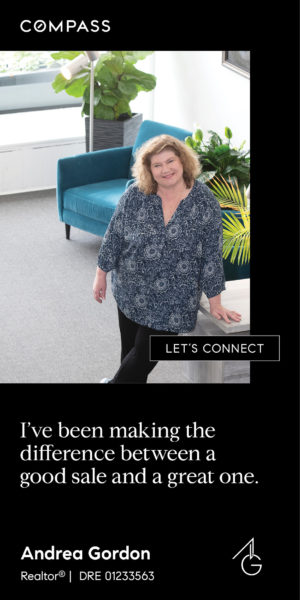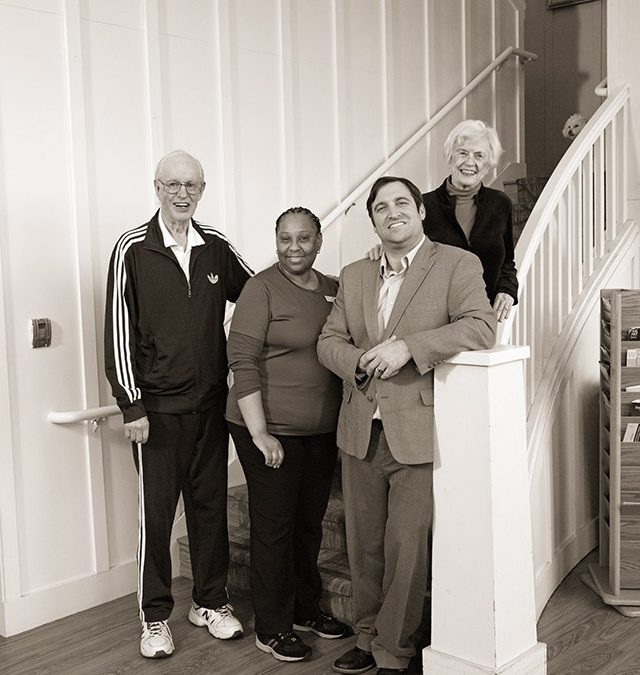Over a decade ago Arana Craftsman Painters had the pleasure of meeting Shannon Bloemker when we were subcontracted to provide our painting and staining services as part of her groundbreaking eco-conscious renovation project.
Shannon and her husband Rob had purchased this Mid-Century Modern style home in Piedmont knowing that it needed A LOT of work. Fortunately, she was the perfect new homeowner for this moment. With her own experience in construction and property management, and a nearly-completed Master’s degree in Sustainability at Harvard under her belt — with only the thesis project to go — the stage was set.
The players included McCutcheon Construction, a Berkeley-based Green Builder who has decades of experience in the remodeling industry and architect Michelle Kaufmann. McCutcheon notes, “The most important factor in creating a sustainable project is to build a great team. That starts with a visionary homeowner like Shannon, and must also include dedicated and experienced team members like Kaufmannn and Arana.”
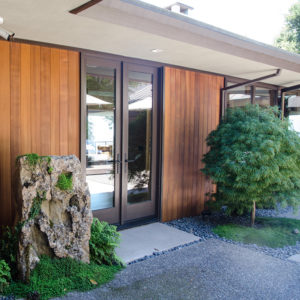
Shannon Bloemker’s prodigious research, work, and care choosing systems and practices that would be better for the planet garnered her remodel project the distinguished honor of being the first LEED Platinum certified remodel in Piedmont, and was awarded “Best Green Renovation,” by the City, in 2012.
According to the U.S. Green Building Council, which maintains the standards and awards system, “LEED certified buildings save money, improve efficiency, lower carbon emissions and create healthier places for people… To achieve LEED certification, a project earns points by adhering to prerequisites and credits that address carbon, energy, water, waste, transportation, materials, health, and indoor environmental quality.” (Learn more at www.usgbc.org/leed)
Now, ten years later, we asked Bloemker to reflect back on her experience and share with us what has worked, and what hasn’t — and what products and systems did or did not withstand the test of time.
Going green sometimes means you have to be an early-adopter, taking risks on systems that might be newer or unproven. Bloemaker reports, for example, that “the greywater system we created was considered cutting-edge at the time — I wrote my master’s thesis on it. The benefit is, it does take all of the ‘greywater,’ (the used water flowing out from the laundry, shower, and sinks) and distributes it to the landscape.
“You have to keep in mind though,” she notes, “there are laws about this. Greywater needs to be distributed to the landscape below the surface; you couldn’t spray that water because it might have bacteria in it. And, since it’s below the ground, the problem is that sometimes you can’t tell if the system has stopped working until a plant dies because it didn’t get any water!”
She adds, “This system was designed as a subsurface wetland, delivering water from our sinks and showers and then filtering it through rock before going out to the landscape plants. It is a solid concept, but requires a lot of maintenance that prevents it from really becoming a mainstream idea.” In addition, the fact that installing a greywater system requires permitting makes it a more expensive and less appealing option for most homeowners.
Bloemker has continued to work with the project designer, Dig Cooperative, who brings new ideas for water innovation as the market evolves. “Greywater systems continue to be a work in progress. Finding creative ways to save water is still critical for those of us who live in the Bay Area.”
Conversely, Bloemker reports that the system her home uses that captures rainwater for use in the washing machine and toilets was a major win. “It’s amazing!” she says. “I’m so happy that we have it. It’s just sort of set-it-and-forget-it and it works great!”
McCutcheon points out that an ongoing relationship with tradespeople and manufacturers, for troubleshooting and maintenance, is also key to sustainability. He says, “A truly sustainable project must stand the test of time, so proper ongoing maintenance is critical. To that end, it is critical to build a team that trusts each other and continues to work together. That way you don’t lose the institutional memory. Success is based on the team’s ability to stay involved long term, not just for the initial project.”
This philosophy has also borne out in the case of the woodwork, a primary feature of the modern-meets-natural style of the Bloemkers’ home. The exterior walls are covered entirely in vertical cedar siding. All of the fencing, enclosures, and vertical and horizontal trellises are also made of cedar.
Over time, cedar has a tendency to turn gray and bleed “tannins,” which end up as black streaks on the surface of the wood. It’s an aesthetic choice for homeowners to not coat their cedar, but at Arana we recommend at least a clear coat stain to provide some UV protection. The cedar on Bloemker’s home is a beautiful red and golden color that she knew she would like to maintain.
“My house has a lot of wood; there’s paneling everywhere! We had the existing woodwork, and then a lot of it was new and all of it had to be stained and color-matched. This takes a very high level of skill. I was so grateful for Arana’s help! We love them.”
She continues, “To be certified as a LEED Platinum home, we had to work within the confines of the program to meet as many green requirements as possible. This meant challenging our contractors and vendors with using different products and different ways to apply them.”
Per these requirements, Arana originally applied a water-based stain on the cedar siding. It looked beautiful, but didn’t last more than a year. The problem with the water-based stain outside is that it didn’t penetrate the wood. It sat on the surface, and that lack of penetration led to fading and didn’t slow down the tannin stains.
“We learned over time that the north-facing vs. south-facing sides of our house get very different sun and weather exposure,” Shannon explains. “So, how we managed the maintenance of the exterior had to change. The north side still has all water-based stain, while the south-facing side has been redone twice. The first time we tried water-based again, to test our hypothesis that the wood had simply soaked up too much of the stain the first time. After the second time, in consultation with Arana, we decided the best choice would be to use the oil-based stain.”
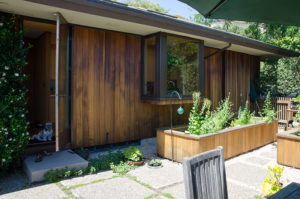
On our third visit, Arana applied Messmer’s semi-transparent stain, an oil-based product known to protect the wood and help it hold its color for up to 3-to-5 years.
What Arana learned from this project is that sustainability requires considering a balance between several factors including the costs of materials consumption, the homeowner’s maintenance budget, and long term impacts on the environment.
Initially a product may appear to use fewer resources, or seem preferable because it introduces fewer toxins into the environment, however, when we analyze what the results will be over time, if toxins are reduced but the process requires an increase in materials consumption or causes a homeowner to have to spend double or triple to redo the same process that a product that isn’t labeled “eco-friendly” could achieve the first time, we might consider going a different route.
Thus, re-staining a home’s exterior annually or having to replace the siding because the more ‘eco-friendly’ product didn’t protect it properly, is not necessarily sustainable.
Another aspect of Bloemkers’ LEED platinum project that did work well and has held up over time, while also being a rather iconic and stunningly beautiful representation of Shannon’s values and goals, is their home’s indoor “living wall.”
A living wall is a vertical structure made up of plants whose function in this situation is to improve air quality while bringing nature indoors. And as indoor plants are also considered to contribute to elevated mood and decreased anxiety, they are a welcome addition whether vertical or planted in pots, though one cannot argue with the impact a vertical arrangement makes.
About the decision to install the living wall, Bloemker says, “I love plants! And I love the whole indoor-outdoor nature of the house itself. Incorporating plants in the design was an easy thing to do, and in our case, we wanted to find a way to make that action more of a statement.”
As far as what plants would fill it, she notes, “We didn’t know what would thrive. It turned out, some of the most basic house plants were the biggest winners; they found their own way.”
The living wall’s plants are watered by an irrigation system that runs up to it from right underneath the house, fed by a tank filled with rainwater — “which I think they love!” she says.
McCutcheon notes that the living wall was another learning process. Original architectural plans had not included the skylight, which the team installed later after they discovered that the plants simply weren’t getting enough light.
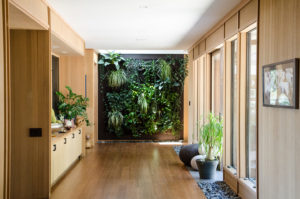
In design and building, these days “Biophilia” is a current trend. While the word may be new or only recently gaining in exposure, the idea of incorporating nature into design was already on Bloemker’s radar a decade ago, was certainly part of the Mid-Century Modern trend in its day, as well as being relevant to the Japanese design elements that inspired the landscaping.
Adding to the biophilic design element of the living wall are the river rocks, placed on both sides of the windows — in the courtyard and along that hallway. “The rocks blur the lines between indoor and outdoor and connect the living environment with the built environment,” notes Bloemker.
Going Green, whether 10 years ago or today, requires one to be an “early adopter” of new technologies. And given that this was Shannon’s Master thesis project she adventured into new territory in several areas of her home. With a decade of experience and use, she reports that some of the systems implemented have stood her in good stead, while others, not so much.
Unfortunately the ultra-thin solar panels she tried were a miss. They looked nice, but didn’t deliver, and the company that produced them went out of business one year after she’d had them installed. “We spent $20K and the panels generate hardly any electricity at all.” She is currently looking to have them painted over and have “traditional” panels installed on top of them.
She explains, “From our experience with that solar system, we investigated the causes — with solar vendors who have stayed in business. We learned why it failed and gained valuable knowledge that we have been able to apply going forward.”
“We now know that the solar system should have had multiple microinverters instead of the single inverter,” McCutcheon explains. “There were shadows on the roof from the trees that were affecting the efficiency of the panels. Of course we didn’t want to take the trees out! But because of the varied shade, the individual panels would put out different amounts of electricity. What we learned is that if you only have a single inverter, the system drops down to the potential of the lowest-producing panel. Ten years ago, in the industry, we just didn’t know that.”
In addition to the evolving wisdom and improvements that happen over time, some items in the early stages of development that were more expensive ten years ago — now costs have dramatically decreased.
One example is LED recessed lights, commonly known as “can lights.” McCutcheon recalls, “Ten years ago, a single LED might cost hundreds of dollars. Also you had to install a baffle around the recessed light in the attic to protect the insulation from the waste heat given off by the can. Plus you were perforating the ceiling (and insulation) at every recessed light which leaked energy. Today we have a simpler solution — surface LED fixtures that do not penetrate the ceiling which we can install for a fraction of the cost.”
Other items that continue to be expensive to produce or use might still be considered worthwhile because of the net benefit to the environment, but that’s a choice a homeowner will have to make. For example, it turns out the recycled-glass tile Bloemker selected for the kitchen and bathrooms was not that expensive relative to similar quality new tile, but it also turned out to be difficult to work with. So in that case, costs appeared in the additional labor, and the need to buy more.
McCutcheon notes, “Shannon was willing to be on the ‘bleeding edge.’ She did that intentionally because she wanted to try out new technologies, to be a proof case for the City of Piedmont and for the wider building community. I give her full credit!”
“There were lessons learned,” Bloemker agrees. And yet, her optimism is unflagging. She emphasizes, “You‘ve got to be willing to push the envelope if you’re trying new stuff, particularly with green technologies. I was willing for something not to be perfect. You have to have some early adopters! People who are willing to try these unproven technologies help advance the development and reduce the cost for the whole market. We can’t actually all wait until something is ‘tried and tested’ before using it in our own homes if we want to see the industry change and grow. Overall the new-and-less-common things we tried at the time were worth it, and I wouldn’t change a thing!”
McCutcheon agrees, “As a society, we rely on pioneers like Shannon to show us the way to a brighter future. We still talk about her house at the AIA (American Institute of Architects) meetings.”
He points out that it’s important to remember, eco-conscious design and renovation doesn’t have to be costly. “There are many simple and relatively inexpensive ways that homeowners can go greener: “Most people reading this article could probably benefit from recapturing their rainwater — even a simple barrel on the porch could capture rainwater that could be used to help water the yard. For more suggestions, check out Rainwater Action (greywateraction.org). You can also consult trusted resources such as the nonprofit organization Build It Green (www.builditgreen.org). Every smart step you take to minimize your impact on the planet will save resources, while making you and your family healthier and happier.”
Bloemker wants people to know that the most basic changes in renovation practices can have the biggest impact. She advises, “Capturing rainwater and using recycled materials and FSC certified (i.e.: sustainably harvested) wood when doing any kind of remodel, which is basically the focus of what we had done, and where McCutcheon and Arana shine, are simple, accessible actions that work well, don’t appreciably add to cost, and don’t require special permitting.”
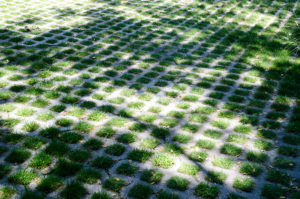
Another big success among Bloemker’s many eco-friendly experiments was what she calls “the grass driveway.” Grasscrete blocks function as both a drivable surface and a lawn of sorts. And the blocks are formed from recycled materials, as well as being recyclable in future if needed; plus they have these spaces (where the grass grows) which allow for easy drainage.
Grasscrete is considered lower maintenance than traditional concrete or paved driveways and allows rainwater to percolate slowly into the soil rather than running off of hard-paved surfaces.
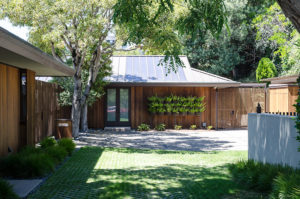
With so much emphasis on doing what’s good for the planet, and with her house’s many windows emphasizing an indoor-outdoor connection, it’s not surprising that landscaping was also a big part of the planning. Aesthetically, Shannon chose to incorporate Asian garden elements, referencing the tendency for Mid-Century Modern architecture to quote a Japanese aesthetic.
The Maple, Acacias, Cypress, and grasses go under that category. She also selected native plants and fruit trees and culinary herbs. Landscaping and a coop for the chickens that free-range are on one side of the house along with plants that are favored by the bees she keeps there as well.
On the other side of the house a basketball court entertains the family’s four sons.
Overall, is Shannon Bloemker happy with how things have turned out, a decade later? Definitely.
She says, “When we bought this home, it was at the perfect crossroads of needs-work and ‘this is something that I‘m really interested in.’ This was a good opportunity to say ‘Well, what is out there? What can we do?’”
And she did.
Resources:
Arana Craftsman Painters: www.craftsmanpainters.com
Build It Green: www.builditgreen.org
Dig Cooperative: www.dig.coop
McCutcheon Construction: www.mcbuild.com
Michelle Kaufmann: www.kaufmannstudio.com
Rainwater Action: www.graywateraction.org
More details about the original project, including text of an article from Dwell magazine:

